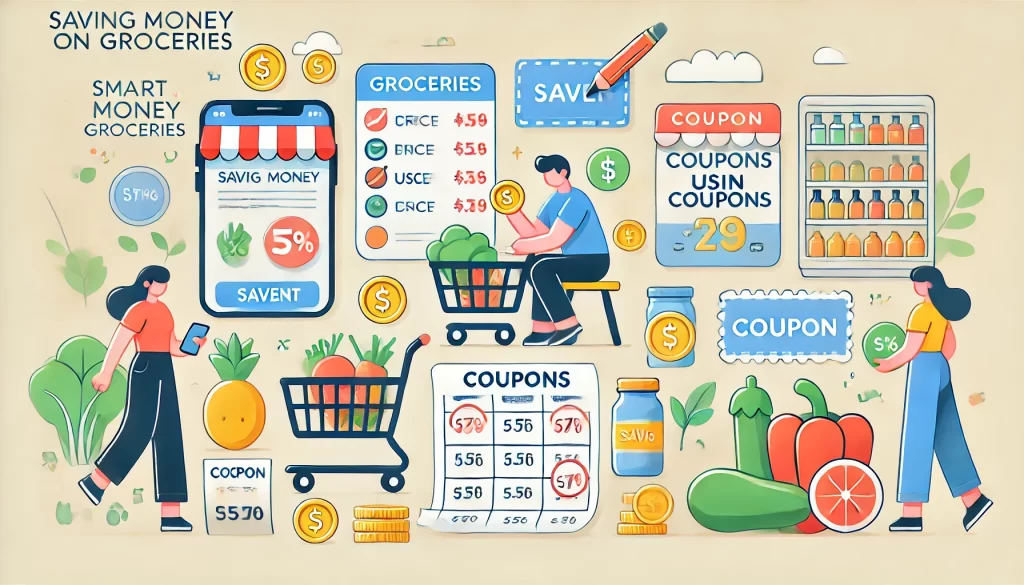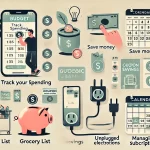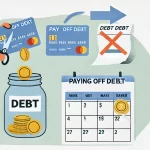In our kitchens and dining tables, we mix home-cooked meals with budgeting. Food prices have gone up 11% from last year. Families spend a lot on groceries, from $975 a month for four to $242 to $303 for one.
When we shop, not all foods are worth it. The best deals are often on shelves that are hard to see. Buying in season can save money and taste great.
Online shopping can also help. It lets us compare prices and avoid buying too much. This way, we can eat well without spending too much.
This guide shows how to save money without losing quality. Look for deals on the edges of stores and online. Buying in bulk and using coupons can also help.
Let’s learn how to shop smart. We can save money by planning our shopping and avoiding impulse buys. This way, we can eat well without breaking the bank.
Strategize Your Meal Planning
Meal planning is more than just a shopping list. It’s a smart way to save money on groceries and avoid food waste. Learning cost-effective grocery shopping strategies can really lower your bills.
Planning Around Sales and Discounts
Check store flyers and discounts often. This helps you plan meals with the best deals. It also means buying quality items for less. Using apps like Ibotta for cashback can save you even more.
Incorporating Leftovers into New Meals
Plan to use leftovers in new meals. This saves money and reduces waste. Turn last night’s chicken into soup or use old veggies in a stir-fry.
Adapting Recipes for Seasonal Produce Availability
Choose fruits and veggies in season for cheaper prices. They taste better and are more nutritious. Changing recipes to use these items saves money and makes meals tastier.
Using these tips can cut your grocery bills. It makes mealtime a fun and money-saving experience.
Embrace Smart Shopping Habits
To cut down your grocery bills without losing quality, smart shopping is key. Using money-saving hacks for groceries can really help your wallet. Making a detailed shopping list helps you avoid buying too much.
The US Bureau of Labor Statistics says many families spend a lot on food each year. This shows how important it is to shop smart.
Another great affordable food shopping trick is to shop when you’re not hungry. This stops you from buying things you don’t need. It also helps you stick to your diet.
Choosing whole foods over convenience foods saves money and helps you eat better. The American Journal of Public Health says eating less meat can save a lot of money.
Shopping when things are on sale is smart. Using coupons can cut your grocery bill by up to 25%. Apps like Honey and Ibotta help you find the best deals.
By shopping smart, you save money and live more mindfully. These habits are good for your wallet and your health. Start using these tips and see your grocery costs go down.
Save Money on Groceries by Buying in Bulk Wisely
Learning how to shop for groceries on a budget is key. Buying in bulk can save you a lot of money. It’s not just about getting more stuff. It’s about being smart with your shopping to save money over time.
Buying in bulk can be smart if you do it right. You need to think about what you need and how much you can use. Here’s how to make bulk buying work for you.
Identifying Non-Perishable Bulk Buys
Look for non-perishable items to save money. Things like rice, pasta, and canned goods last a long time. They’re great for many meals and help you save money by not having to shop as often.
Avoiding Waste with Proper Storage Solutions
Good storage is key to keeping food fresh. Use quality containers and make the most of your storage space. This keeps your food fresh and your money safe.
Maximizing Bulk Purchases through Meal Prepping
Meal prepping is a smart way to use up bulk items. Plan your meals and use what you bought. This saves time and money. It also helps you avoid throwing away food.
For more ways to save money, check out this guide. It talks about saving on utilities, managing debt, and living simply.
Buying in bulk doesn’t mean you have to settle for less quality. It’s about making smart choices that fit your needs and budget. Plus, using the right credit cards can give you cash back on your grocery bills. This makes buying in bulk even more rewarding.
By following these tips, you can make your grocery shopping more affordable. You’ll get more value for your money and help manage your household budget better.
Leverage Coupons and Loyalty Programs
As expenses keep going up, finding ways to save on groceries is key. One great way is to get good at couponing for groceries. Some days, stores even double the value of coupons. This means you can buy things for much less.
Using loyalty programs with these coupons can make savings even better. You get special deals and benefits just for being a member.
In today’s world, apps from stores like Kroger or Walmart can help a lot. They give you digital coupons and tell you about the best deals. This turns grocery shopping into a fun hunt for savings.
People who watch their spending can also get store newsletters or follow stores on social media. This way, they catch special deals or last-minute offers.
Being smart about what you buy is also important. Buy things you always need in bulk, especially when they’re on sale. Use apps to track prices so you always get the best deal. This way, you save money now and in the future, like earning points for free stuff.
To save money on groceries, mix old and new ways. Use coupons, apps, and stay updated on sales. With a little effort, you can find lots of ways to save.
Opt for More Affordable Proteins
To save money on groceries, choose cheaper protein sources. Proteins are a big part of what we spend on food. But, there are ways to cut costs without losing taste or nutrition.
Incorporating Plant-Based Proteins into Your Diet
Plant-based proteins like lentils and black beans are good for your wallet and health. A pound of lentils costs about $1.50 and has 9 grams of protein per half-cup. Black beans are also cheap, at $1 per can, and have 7.6 grams of protein per half-cup. Adding these to your meals can cut down on protein costs and increase fiber.
Finding Deals on Meat and Poultry
Meat and poultry don’t have to be expensive. Look for less common cuts or buy in bulk when they’re on sale. For example, chicken thighs are often cheaper and tastier than breasts. Also, watch for discounts on meat products near their expiration dates. These can be used right away or frozen for later.
Extending Meats with Vegetables and Grains
To stretch your meat budget, add veggies and grains to your meals. This makes your food go further and adds more nutrients. For instance, adding mushrooms or carrots to burgers or meatballs increases the serving size and nutritional value. This is a key way to save money on groceries.
By using these tips, you can eat a variety of protein-rich foods without spending a lot. Making smart choices about proteins can save you money without sacrificing taste or variety.
Understand and Utilize Food Labels Effectively
Learning to read food labels is key to saving money at the grocery store. It helps you find cost-effective grocery shopping strategies and money-saving hacks for groceries. By using the info on labels, you can save a lot without losing quality or nutrition.
Unit pricing on labels shows the cost per ounce of different sizes and brands. For instance, a bigger bag of rice might cost less per ounce than smaller ones. This helps you buy in bulk wisely, matching your needs and storage space.
‘Best by’ and ‘use by’ dates help cut down on food waste. These dates don’t mean food is bad after them. They just show when it’s at its best. This way, you can save food like yogurt and cereals that’s still good to eat.
Labels also tell you about fat, sugar, and salt in foods. This helps you stick to your diet without spending more on special products. Choosing store brands that fit your diet can save you money every day.
Using nutrition labels helps you shop healthily without spending too much. It’s great for managing diets for conditions like diabetes or high cholesterol. This way, you can stay healthy without breaking the bank.
Using food labels well is a smart way to save money. It makes every trip to the grocery store cheaper. It also helps you waste less food and stay healthy.
Conclusion
With grocery prices going up, it’s key to find ways to save. From 2021 to 2022, prices rose by up to 11%. Recently, they went up another 2.4%.
For most people in the U.S., grocery bills range from $242 to $303 a month. For a family of four, it’s about $975. Using smart frugal grocery shopping tips can really help save money. It’s about spending wisely, not just less.
By using 30 money-saving hacks for groceries, families can save a lot. They can buy seasonal produce and stick to a list to avoid impulse buys. Programs like The Dinner Daily also help track budgets.
Creating a detailed grocery list can save up to 20% of food costs. It also saves time, letting shoppers finish up to 30% faster.
There are many ways to eat well without spending a lot. Planning meals, avoiding shopping when hungry, and growing your own food are good ideas. These strategies help you get the most value from your grocery trips.
Being dedicated to these tips can keep your pantry and wallet full. It’s all about making smart choices at the supermarket.






